Reading time 5 minutes
NIEUW PROJECT WATER AT THE HEART OF CLIMATE ACTION
Drought and conflict hurt Ethiopia
The need in Ethiopia is high, partly due to the impact of natural disasters and conflicts. The new 'Water at the Heart of Climate Action' project uses local knowledge and the latest scientific insights and technologies to be better prepared for humanitarian disasters.

Water is a basic need. A shortage of water, for example due to natural disasters or armed regional conflicts, immediately creates serious humanitarian need. Ethiopia has been struggling with a massive drought since 2020. "The rainy season this year was better than expected," says Lisa Zitman, Partnerships Coordinator for Ethiopia and Zambia. "But in the years before that, there was much less rain than there should be. There were hardly any reports about this in the news."
The country and its people are still recovering from the effects of the drought. Unfortunately, the near future does not look good. The natural phenomenon El Niño brings heavy rain. Resulting in major flooding. The Ethiopian Red Cross is working with the International Federation of the Red Cross on a DREF/emergency relief operation. "Due to the climate crisis, dry spells will occur more frequently and last longer, as will severe flooding."
Complicated conflict
Another cause of the high needs in Ethiopia is armed conflicts in different parts of the country. Including the recent escalation in Amhara, a region where the Netherlands Red Cross supports many projects. Humanitarian needs also remain high in Tigray. During the conflict from 2020 to 2022, millions of people were displaced and a lot of the infrastructure was destroyed. This has a huge impact on water supplies and healthcare, among other things. "Unfortunately, there is little international attention for this. That is why, as the Red Cross, we continue to look for ways to draw attention to this."
The conflicts also has a huge impact on the delivery of aid, as affected areas are often difficult to reach. "Before we can provide assistance, basic safety for our employees must be guaranteed. For example, there have been attacks on ambulances in the past, which is why we look at every situation carefully. It is also very important to safeguard the neutrality of the Ethiopian Red Cross. That is difficult in local conflicts."

Somali region Kellafo District. Hand-dug water pump installation and rehabilitation
Water at the Heart of Climate Action
The Netherlands Red Cross has been working with the Ethiopian Red Cross since the 1930s. The support from the Netherlands Red Cross is a combination of long-term projects, emergency aid and investments in strengthening the Ethiopian Red Cross itself.
In September 2023, a new project was launched in collaboration with the International Federation of Red Cross and Red Crescent Societies (IFRC) and other organizations. The funding for 'Water at the Heart of Climate Action' comes from the Ministry of Foreign Affairs. "This partnership builds on years of experience of the Ethiopian and Netherlands Red Cross in the field of prevention and water management," explains Lisa. This goes beyond installing water pumps and toilets and sharing knowledge about hygiene. "We look at the impact of water-related disasters on the landscape and facilities. We are also looking at how we can reduce the negative consequences."
Importance of good data
One way to be stronger against natural disasters is to collect and analyze data, for example on weather patterns. "To make good use of this data, local structures are needed that have access to the communities that live in high-risk areas. With this date, we can support communities and they are better prepared for disasters. We use the data information, for example, to protect houses and farmland against flooding. In addition, thanks to this data, we have introduced drought-resistant seeds."
Good structures are essential in times of need. "Not only are we trying to better predict when things will get out of hand, but we also make sure that the warnings get to the right places quickly. In case of acute emergency, we must inform the population as soon as possible so that they can get themselves to safety."
Resilient communities
"Fortunately, we have started the relief efforts in Tigray. Previously, this was not possible due to the conflict. We also support various projects in the Amhara region. This region is currently experiencing a large influx of internal refugees. At the same time, the Amhara region is also a shelter for refugees from Sudan. In Somali, in the east of the country, we are focusing on drought relief with a project."
'Water at the Heart of Climate Action' is an important step to better cope with future emergencies. "We always have to take into account that the feasibility of our plans or projects can change suddenly. That is why self-reliance is always a goal within our care. We not only try to help in acute emergencies, but also look ahead to make local communities more resilient."

Somali region Kellafo District. Hand-dug sump pump installation and rehabilitation | Somali region district of Gode. Direct multi-purpose money distribution